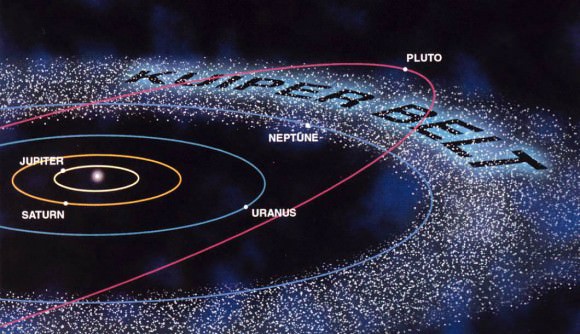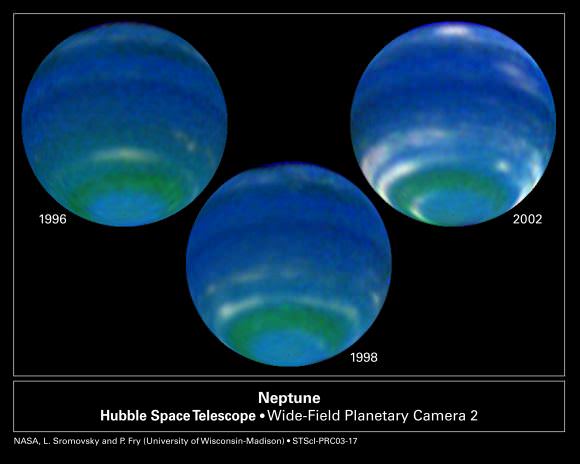Here on Earth, a year lasts roughly 365.25 days, each of which lasts 24 hours long. During the course of a single year, our planet goes through some rather pronounced seasonal changes. This is the product of our orbital period, our rotational period, and our axial tilt. And when it comes to the other planets in our Solar System, much the same is true.
Consider Neptune. As the eight and farthest planet from the Sun, Neptune has an extremely wide orbit and a comparatively slow orbital velocity. As a result, a year on Neptune is very long, lasting the equivalent of almost 165 Earth years. Combined with its extreme axial tilt, this also means that Neptune experiences some rather extreme seasonal changes.
Orbital Period:
Neptune orbits our Sun at an average distance (semi-major axis) of 4,504.45 million km (2,798.656 million mi; 30.11 AU). Because of its orbital eccentricity (0.009456), this distance varies somewhat, ranging from 4,460 million km (2,771 million mi; 29.81 AU) at its closest (perihelion) to 4,540 million km (2,821 million mi; 30.33 AU) at its farthest (aphelion).

The orbit of Neptune and the other outer Solar planets, as well as the ice-rich Kuiper Belt that lies just beyond it. Credit: NASA
With an average orbital speed of 5.43 km/s, it takes Neptune 164.8 Earth years (60,182 Earth days) to complete a single orbital period. This means, in effect, that a year on Neptune lasts as long as about 165 years here on Earth. However, given its rotational period of 0.6713 Earth days (16 hours 6 minutes 36 seconds), a year on Neptune works out to 89,666 Neptunian solar days.
Given that Neptune was discovered in 1846, humanity has only known about its existence for 171 years (at the time of this article's writing). That means that since its discovery, the planet has only completed a single orbital period (which ended in 2010) and is only seven years into its second. This orbital period will be complete by 2179.
Orbital Resonance:
Because of its location in the outer Solar System, Neptune's orbit has a profound impact on the neighboring Kuiper Belt. This region, which is similar (but significantly larger) than the Main Asteroid Belt, consists of many small icy worlds and objects that extends from Neptune's orbit (at 30 AU) to a distance of about 55 AU from the Sun.

Animated diagram showing the spacing of the Solar Systems planet's, the unusually closely spaced orbits of six of the most distant KBOs, and the possible "Planet 9". Credit: Caltech/nagualdesign
So much as Jupiter's gravity has dominated the Asteroid Belt, affecting its structure and occasionally kicking asteroids and planetoids into the inner Solar System, Neptune's gravity dominates the Kuiper Belt. This has led to the creation of gaps in the belt, empty regions where objects have achieved an orbital resonance with Neptune.
Within these gaps, objects have a 1:2, 2:3 or 3:4 resonance with Neptune, meaning they complete one orbit of the Sun for every two completed by Neptune, two for every three, or three for every four. The over 200 known objects that exist in the 2:3 resonance (the most populous) are known as plutinos, since Pluto is the largest of them.
Although Pluto crosses Neptune's orbit on a regular basis, their 2:3 orbital resonance ensures they can never collide. On occasion, Neptune's gravity also causes icy bodies to be kicked out of the Kuiper Belt. Many of these then travel to the Inner Solar System, where they become comets with extremely long orbital periods.
Neptune's largest satellite, Triton, is believed to have once been a Kuiper Belt Object (KBO) - and Trans-Neptunian Object (TNO) - that was captured by Neptune's gravity. This is evidenced by its retrograde motion, meaning it orbits the planet in the opposite direction as its other satellites. It also has a number of Trojan Objects occupying its L4 and L5 Lagrange points. These "Neptune Trojans" can be said to be in a stable 1:1 orbital resonance with Neptune.
Seasonal Change:
Much like the other planets of the Solar System, Neptune's axis is tilted towards the Sun's ecliptic. In Neptune's case, it is tilted 28.32° relative to its orbit (whereas Earth is tilted at 23.5°). Because of this, Neptune undergoes seasonal change during the course of a year because one of its hemispheres will be receiving more sunlight than the other. But in Neptune's case, a single season lasts a whopping 40 years, making it very hard to witness a full cycle.
While much of the heat that powers Neptune's atmosphere comes from an internal source (which is currently unknown), a study conducted by researchers from Wisconsin-Madison University and NASA's Jet Propulsion Laboratory revealed that seasonal change is also driven by solar radiation. This consisted of examining images of Neptune taken by the Hubble Space Telescope between 1996 and 2002.
These images revealed that Neptune's massive southern cloud bands were becoming steadily wider and brighter over the six year period - which coincided with the southern hemisphere beginning its 40-year summer. This growing cloud cover was attributed to increased solar heating, as it appeared to be concentrated in the southern hemisphere and was rather limited at the equator.

Images taken by Hubble, showing seasonal change in its southern hemisphere. Credit: NASA, L. Sromovsky, and P. Fry (University of Wisconsin-Madison)
Neptune remains a planet of mystery in many ways. And yet, ongoing observations of the planet have revealed some familiar and comforting patterns. For instance, while it's composition is vastly different and its orbit puts it much farther away from the Sun than Earth, its axial tilt and orbital period still result in its hemispheres experiencing seasonal changes.
It's good to know that no matter how far we venture out into the Solar System, and no matter how different things may seem, there are still some things that stay the same!
We have written many articles about how long year is on the Solar planets here at Universe Today. Here's The Orbit of the Planets. How Long Is A Year On The Other Planets?, The Orbit of Earth. How Long is a Year on Earth?, The Orbit of Mercury. How Long is a Year on Mercury?, The Orbit of Venus. How Long is a Year on Venus?, The Orbit of Mars. How Long is a Year on Mars?, The Orbit of Jupiter. How Long is a Year on Jupiter?, The Orbit of Saturn. How Long is a Year on Saturn?, The Orbit of Uranus. How Long is a Year on Uranus?, The Orbit of Pluto. How Long is a Year on Pluto?
If you'd like more information on Neptune, take a look at Hubblesite's News Releases about Neptune, and here's a link to NASA's Solar System Exploration Guide to Neptune.
We have recorded an entire episode of Astronomy Cast just about Neptune. You can listen to it here, Episode 63: Neptune.
Sources:
No comments:
Post a Comment